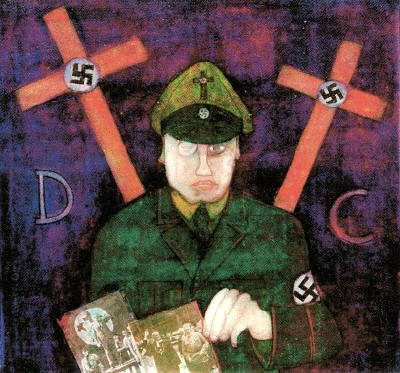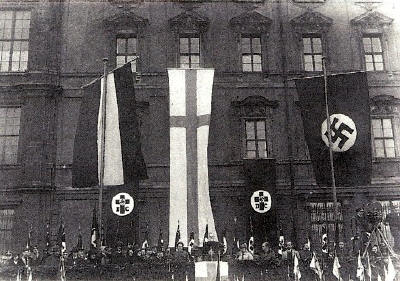|
Site Map THE DOUBLE CROSS |
|
by Fritz Hirschberger
Artist's Comment The hooked cross (swastika) placed in the center of the traditional symbol of Christianity, was adapted by the protestant "German Christian Movement" (Deutsche Christen or short D.C.) as their symbol. As a group within the German Protestant Church it was openly endorsed by the Nazi party. Dominating in 1933 the unifying process of the 29 regional churches into the Protestant Reich Church. The Deutsche Christen managed to get Ludwig Muller, one of their own ,elected "Reich Bishop". One of their credos:
Institute for Research into and elimination of Jewish influence in the German Church Life. 1941 Docent Guide, by chgs.umn.edu The Swastika is originally a symbol that came from India and is still found in abundance as a symbol in Hindu culture. It is a symbol of "good luck." Hitler took the symbol, which is believed to have been part of the carvings in the Catholic Church he attended in Linz, Austria, reversed the field so the symbol became more dynamic moving from left to right, and made it the symbol of his political party-NSDAP-The Nazi Party. Other scholars have recalled it is a variant of a Greek cross, found in many decorative elements before the twentieth century. In this painting, however, Hirschberger is reflecting on more than the
Swastika symbol itself, but how it was merged with the essential Christian
symbol. After 1933, the German Christian Movement (Deutsche Christen or
"DC") displayed the traditional cross with a Swastika at the point of
crossing, with an "D" and "C," symbolizing the name of the Church. In
English, the D and C stand for "doublecross," the sign of the Swastika and
also possibly an allusion to the image of the "Doublecross" in Charlie
Chaplain's famous 1940 film, "The Great Dictator." In this painting, the image of Party Member and Church official are blended, as indicated by the cross on the hat. "D" and "C" appear as a visual text. The image of the official holds two photos showing activities by the Church in service to the Nazis. Hirschberger this has blended his own interpretation with the reality of the documentary photograph. Charlie Chaplain's 1940 American film, "The Great Dictator," used the symbol of "the double cross" for the flag of the Hitler look-alike. In English, the word "doublecross" has meaning, which relates to the treachery of the Nazis and the false promises that ultimately led to the destruction of Germany as well as its victims. |

